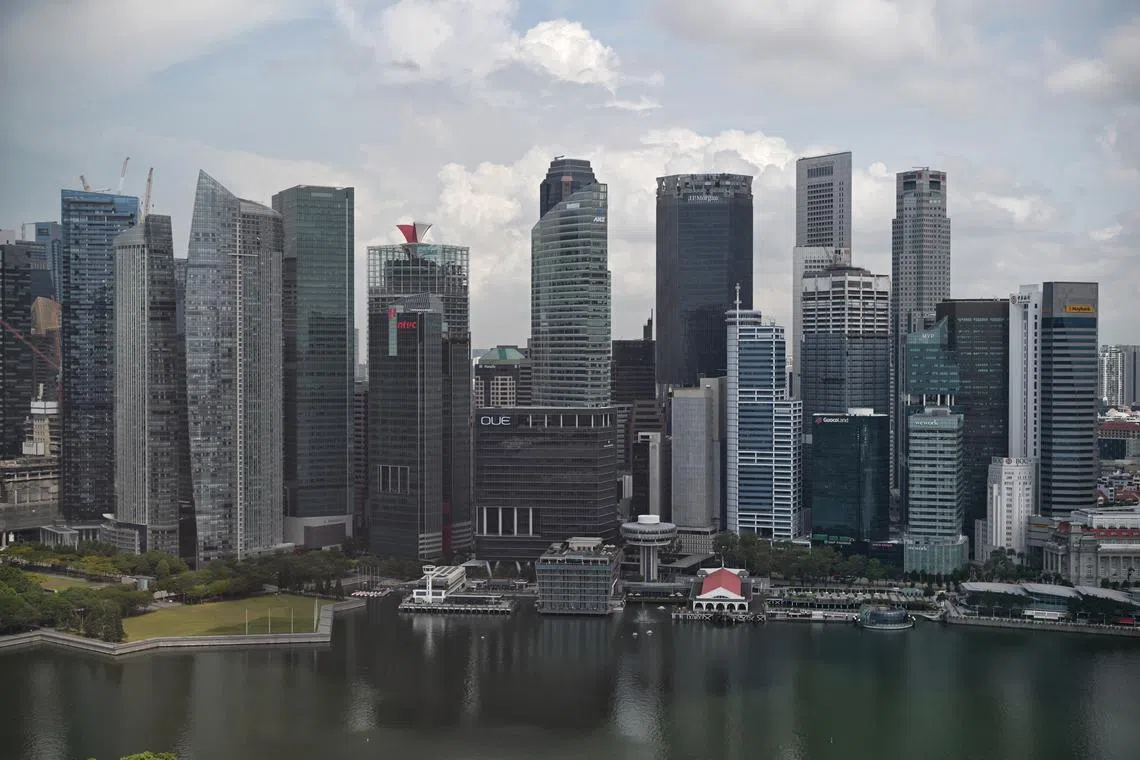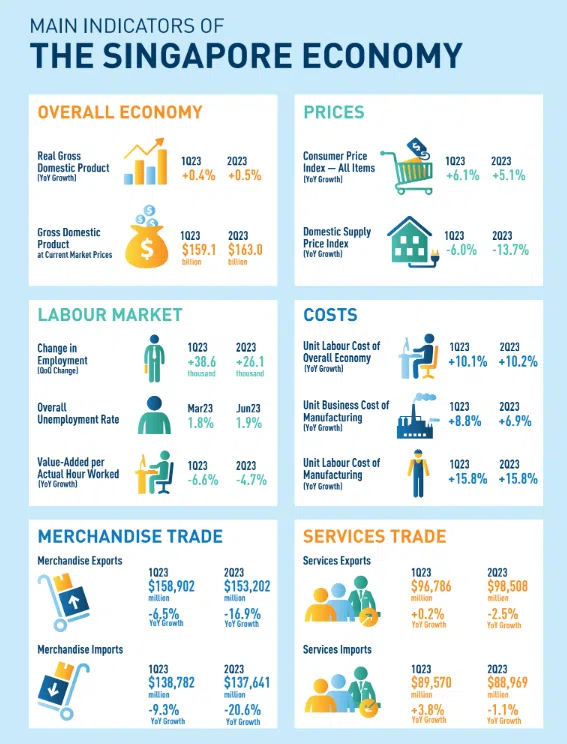Singapore cuts 2023 economic growth forecast to 0.5-1.5% on weak export outlook
Sign up now: Get ST's newsletters delivered to your inbox

The growth forecast was narrowed from an earlier range estimate of 0.5 per cent to 2.5 per cent.
ST PHOTO: KUA CHEE SIONG
Follow topic:
SINGAPORE - Singapore downgraded its economic growth forecast for 2023 to between 0.5 per cent and 1.5 per cent amid a weak outlook for the export-driven manufacturing sector.
The growth forecast was narrowed from an earlier range estimate of 0.5 per cent to 2.5 per cent after the economy grew by an annual 0.5 per cent in the second quarter of 2023 and 0.4 per cent in the first three months, said the Ministry of Trade and Industry (MTI) on Friday.
On a quarter-on-quarter seasonally adjusted basis, the economy eked out growth of just 0.1 per cent, a reversal from the 0.4 per cent contraction in the first quarter of 2023, narrowly avoiding a technical recession, or two consecutive quarters of contraction.
Both the year-on-year and quarter-on-quarter figures for second-quarter growth were lower than flash estimates made in July.
In July, MTI said the economy grew 0.7 per cent year on year and 0.3 per cent quarter on quarter.
Ms Yong Yik Wei, MTI chief economist, said that since growth averaged about 0.4 per cent year on year in the first half, the new forecast means the ministry is looking at the second half for relatively higher growth compared with the first six months.
“Sequentially (quarter on quarter) again we are not expecting a technical recession. We are looking at a modest recovery profile, anchored by things like inbound tourism and resilience of the consumer-facing sectors,” she said at a media briefing on Friday.
If the electronics down cycle bottoms out towards the end of 2023, that should help as well, Ms Yong noted.
On Friday morning, Singapore also downgraded its export forecasts for 2023
MTI said the manufacturing sector shrank by 7.3 per cent year on year in the April-June period, worse than the 5.4 per cent contraction in the previous quarter.
Both manufacturing and non-oil domestic exports (Nodx) have shrunk in the past nine months.
Meanwhile, growth in two of Singapore’s major trading partners – China and the United States – is likely to moderate in the second half of 2023, weighing on the external demand outlook.
HSBC economist Yun Liu said that while Singapore may have avoided a technical recession, its trade-related sectors remain in the doldrums and despite some initial signs that point to stabilisation in the electronics cycle, a meaningful turnaround is still not visible.
“The slight downward revision to growth (for the second quarter) reminds one of the mounting challenges to Singapore’s economy,” she said.
However, Ms Liu added that travel-related services, which account for 10 per cent of gross domestic product (GDP), continue to show much-needed momentum.
Indeed, tourism arrivals have recovered to more than 70 per cent of 2019’s pre-pandemic level.
MTI said that the growth outlook for aviation- and tourism-related sectors such as air transport and accommodation remains positive given the ongoing recovery in international air travel and inbound tourism.

SOURCE: MINISTRY OF TRADE AND INDUSTRY SINGAPORE
Meanwhile, consumer-facing sectors such as retail trade and food and beverage services are expected to continue to expand,
At the same time, downside risks in the global economy remain, said MTI.
These include more persistent than expected inflation in the advanced economies, which could induce tighter global financial conditions and lead to a larger retraction in global spending, as well as the risk of escalations in the war in Ukraine and geopolitical tensions among major global powers.
Other data out on Friday showed consumer prices in Singapore rose 5.1 per cent year on year in the second quarter of 2023, moderating from the 6.1 per cent increase in the preceding quarter.
Mr Edward Robinson, deputy managing director at the Monetary Authority of Singapore (MAS), said the central bank will maintain its forecasts of 4.5 per cent to 5.5 per cent for overall inflation and 2.5 per cent to 3 per cent for core inflation, which excludes accommodation and private transport costs.
He said both core and overall inflation have peaked from their highs and a gradual disinflation – a decrease in the momentum of price increases – is likely to continue.
He also reiterated that MAS’ monetary policy stance remains appropriate, though the central bank is also vigilant to overall price developments.
Replying to a question at the briefing, Mr Gabriel Lim, MTI’s permanent secretary, said the Government is monitoring the recent surge in oil and food grain prices, especially the price of rice, which has risen to multi-year highs.
“We are continuing to watch this and monitor this very carefully, and are prepared to step in with further assistance if necessary,” he said.
DBS economist Chua Han Teng said Singapore’s economic outlook is still fraught with downside external risks, amid a still uncertain global economic climate posed by tight monetary policy in advanced economies and bumpy Chinese recovery.
Still, Mr Chua maintained his 2023 GDP forecast of 1.2 per cent, saying the estimate reflects expectations for a gradual recovery in the second half.
“Singapore’s manufacturing sector remains weak, but the downturn appears to be past its nadir, while the services expansion is likely to stay supportive,” he said.
Business sentiments among hospitality-related services clusters are the most positive among services companies.
“They are likely to enjoy tailwinds from the ongoing normalisation in international travel amid returning Chinese tourists, and large-scale events including the Singapore Grand Prix,” said Mr Chua.


